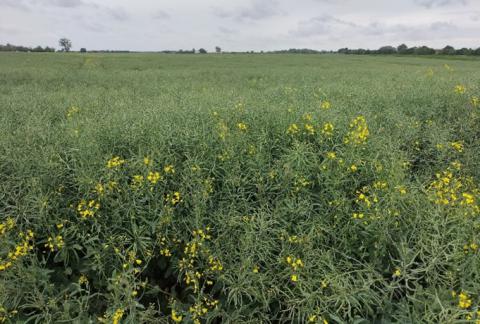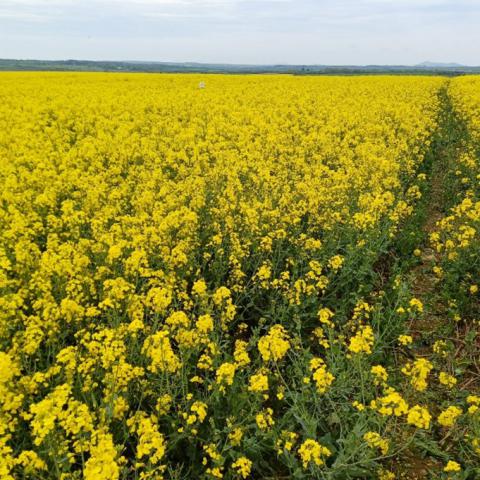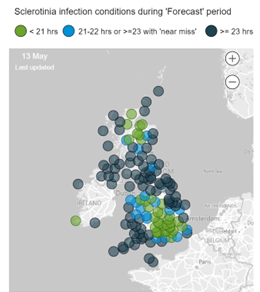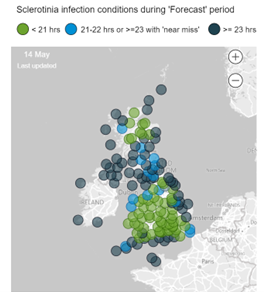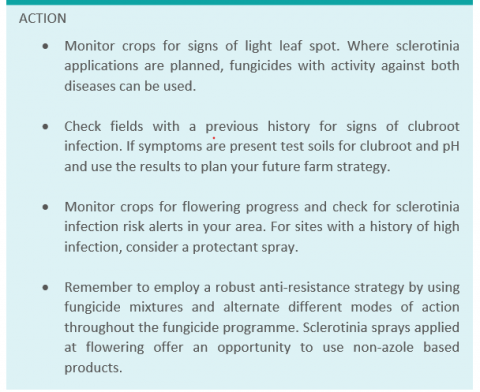Phil Walker
Winter Oilseed Rape Disease Management
Light leaf spot continues to be reported with symptoms seen on leaf canopies and on the stem as either sporulation, black speckling, greasy brown or purple blotches or scarring (Figure 1). Typically, as the leaves senesce light leaf spot symptoms usually start to become more pronounced on the stems and become visible on the pods. Infection on the pods can cause pod distortion with resulting yield losses. Where light leaf spot is still a problem, a good strategy when selecting fungicides targeted at sclerotinia is to select flowering spray products which also have activity against light leaf spot. However, it is important to choose sclerotinia fungicides with a different active than any used for light leaf spot control, especially if you are considering a second flowering application, to reduce the rate of development of fungicide resistance.
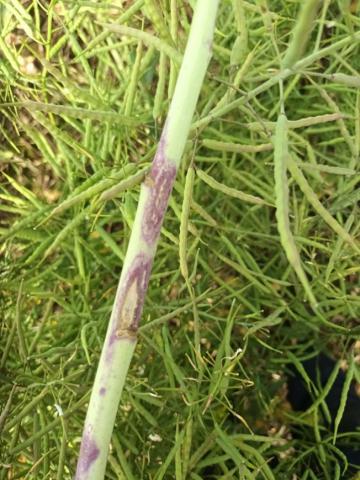
Figure 1. Stem light leaf spot visible as purple blotches, scarring and sporulation from a trial site near Long Sutton, South Lincolnshire. Source: ADAS.
There is a prolonged flowering period this season and most oilseed crops have been in flower now for the past five to six weeks. The progress of flowering crops has varied, with the more forward crops coming to the end of flowering while others are at the mid-flowering stage (Figure 2). Sclerotinia infection periods at late-flowering stages can still pose a significant risk to crops, as infection can develop on the lateral branches causing yield losses by preventing pod formation. In many cases crops were sprayed when in in full flower, with most fungicide applications only recently applied, which could provide a window of protection long enough to avoid the need for a second treatment. For those crops which had a fungicide more than three weeks ago, the persistence of this treatment has now likely expired and there could be a need for a second application if the risk of infection is considered high enough.
The thresholds for a sclerotinia risk alert are temperatures >7oC and humidity > 80%, for 23 or more consecutive hours, and usually light rain is also required to allow the fallen petals to adhere to the canopy. Petal testing at ADAS sites sampled at the end of last week has shown varied levels of inoculum present with 45% positive in Herefordshire, but higher levels of 83% positive nearer the coast in Llandeloy, Pembrokeshire. A positive petal test for a site with a weather-based alert will help to confirm it as high risk for sclerotinia infection. The latest AHDB sclerotinia forecast has shown that this week has been high risk for nearly all areas of the UK, where rain showers and cloud cover has kept humidity above threshold (Figure 3), and continues to remain high in northern and coastal areas https://ahdb.org.uk/sclerotinia-infection-risk-alerts-for-oilseed-rape. Temperatures have been hot and are forecast to stay above 7oC over the coming week, however, drier conditions may result lower humidity so the sclerotinia forecast should be monitored for the risk in your area.
Spore monitoring data from AHDB has shown an increase in sclerotia inoculum present and there is likely to be localised risk depending on the history of sclerotinia infections in particular fields. For crops in areas of high risk, a spray application may be considered for fields which have yet to have a fungicide at mid-flower or for those showing prolonged flowering that require a second treatment.
